QuestionQUESTION: Hi Diane, I am a new leopard gecko owner and I guess like any pet owner I just want to make sure that I am doing everything to keep my new pet healthy. I got my juvie about two days ago and everything seems to be pretty normal. It has a nice plump tail, is alert, and is active and climbs everywhere during the night time. I keep a dish of fresh water in the cage as well as a small dish of calcium powder. I've seen it drink and I believe it's been dipping in the calcium dish because there are little trails everywhere. The only thing I am concerned about at this point is that it hasn't really eaten since I've gotten it. I use small crickets as a food source. I within the past couple of days I think it has eaten maybe 2-3 of the crickets that I've dropped in there (usually I drop in 4 a night) I take out crickets that I find roaming...so far it seems that the gecko only eats maybe 1 or 2 a night since I usually take out 2 or 3 left over crickets. I also haven't found any poop in the cage. From my research it seems that stress symptoms are similar to symptoms of a sick gecko. Should I be concerned about a health issue or could stress be causing it to not eat much? How long can a gecko go without eating/pooping?
ANSWER: Hi Loretta,
Congrats on your new pet!!!Good on the tail, etc...They are nocturnal so active at night is normal.. I love the little footprints in the calcium!!! You are correct on the stress thing...they can go quite a while without eating when they have a nice fat tail. Leos HATE change and moving to a new home is change..change=stress for them. Stress=not eating.
Do you have lots of things in the cage that the crickets can hide in? If so, you may want to feed your leo in a smaller cage that has nothing else in but hum and the crickets. If your leo seems to not like the chase of the crickets, you can break the hind legs on the crickets which will prevent them from jumping. You can also cool the crickets down for a few minutes in the fridge before feeding them to your leo. This will also slow the crickets down.
Leos tend to hind their poop very well in their cage..but, if he isn't eating much, it will take a while for him to have to poop. Also, incorrect temperatures can cause them to not eat. I am including a basic care sheet that I wrote to help people out with caring for their leos. Please read carefully the section on heating/temperatures and how its best to have the area set up.
As long as he is drinking, active and is eating a few crickets, no need to worry at this point...but if he continues to not eat,(days into a week) his energy changes, etc, then a vet visit for a fecal check is a good idea. Stress can increase their internal parasite load which can cause lack of appetite....but..first check all your care, etc.
BASIC CARE FOR A LEOPARD GECKO
Leopards are pretty easy to care for but they do need
special care. Here are some of the basic needs of your gecko.
HOUSING: The need to have at least a 20 gallon long tank for one Leo. This needs to have a secure fitting screen top...they can be quite the escape artists!!! They need to have a humid hide box.You can make this with something as simple as a small plastic dish with a hole cut in one side and a small mesh bag filled with some Sphagnum moss coconut bark or Peat moss that you mist.
I made mine out of the small plastic folgers coffee containers...I cut an opening in the lid..and put the moss in..they LOVE it. I use the terrarium moss in mine.
I use that on the warm side of the tank. Be sure to provide a cool hidebox on the other end. I also provide a mid temperature hide...which is in the middle of the tank.I use the critter caves which you can purchase. NOT the ones that have heat in them!!!!
Provide secure climbing areas for your gecko. Fake plants, rocks and branches are all fine to use. be sure there are no wires or sharp ends to any fake plants you use.
*****SUBSTRATE:(that's the stuff on the floor of your tank) Newspaper, lizard carpet or paper towels work great and are easy to clean and are much safer than any loose substrate. Sand or other loose substrate is not recommended as that they can be deadly to the leo when it is ingested(eaten, even by accident while eating their insects)...A very graphic site of an impacted leo surg can be seen at http://homepage.mac.com/exoticdvm/reptile/PhotoAlbum181.html it is very graphic!!! ******What I have found that works great for safety and heat distribution is using about 1/4 inch of childrens play sand(since the tiles fit tight together, there is no sand danger) on the bottom of the tank and on top that you place ceramic or slate floor tile. What is nice is that the 12 x 12 squares fit perfect in a 20 gallon tank with no spaces between the tiles. The sand and the tile distribute the heat wonderfully. Using the under tank heater as described is what distributes the heat. Also, overhead heat will help in heating the tiles...I've been using this set up for several years and the leos love it. Using a tile that isn't smooth is recommended. **********
TEMPERATURES: They need a warm area ( on the floor) of 88-92 degrees and a
cooler area in the upper 70s, low 80s. At night their temperature can drop to the low to mid 70's.
Never use a hot rock for a leopard gecko...or any reptile.
They can severely burn any reptile. You can use a heating
pad under the tank,under tank heater for the warm area. You can use a regular household lightbulb in a dome fixture with a ceramic socket in it to keep the warm area at the 88-92 degree area if needed there, otherwise, placing the lightbulb about midway in the tank will give the needed temeratures throughout the tank. You may have to play with the wattage of the bulb but generally 40-60 watts is sufficient.At night, no white light. If room temperatures stay above 70 degrees, no extra night heat is needed. The undertank heater or heating pad should cover about 1/3 of the tank....be sure to raise the tank up about 1/4-1/2 inch off the stand when using an undertank heat source to prevent heat build up which can cause the glass to break and hot spots in the glass. Be sure to have a good layer of newspaper, carpeting or, even a thin flat rock(such as tile) on top the area that the undertank heat source is placed...if you use a thin rock or tile, it helps to distribute the heat very well.
You can use the special nighttime lights that are designed for reptiles. I like using a ceramic heat emitter on a thermostat for nighttime heat.
DO NOT use black lights or party lights as they can cause eye damage!!!!
The wattage you use will vary based on room temperature and size of tank.
LIGHTING: Leopard geckos do not need UVB lighting but it does not hurt them to give them uvb. They should have some type of light during the day, be it a uvb tube, regular florescent light, reptile day light or regular household lightbulb. NO white lights at night!!!
FEEDING: Geckos should not be fed crickets or other insects that are bigger than the space between their eyes. Generally, hatchlings can be fed more than once a day,juvys can be fed twice a day, adults are fed once daily or every other day, in the early evening. Crickets and other food items such as silk worms, super, and an occasional treat of a wax worm, need to be dusted with a calcium supplement two times a week and also they should have a small dish of calcium in their tank. I use the lid of a milk jug for the little dish of calcium in their tank. For dusting the insects, Use a calcium with no added phosphorus. Insects must be gut loaded(fed) for at least 48 hours prior to feeding your gecko. Remove any uneaten crix or superworms after 15-20 minutes..... Place a piece of cut potato in the tank so that if you have missed any uneaten insects, they will eat the potato instead of nibbling on your gecko!!!
*************You have to be sure to feed your crickets and insects the right foods before feeding them to your gecko. If your crickets/insects are not healthy and well fed, your gecko will not get the nutrition he needs. You can gut load your crickets and insects greens, veggies, cereals or specially designed commercial foods for crickets or the insects you are feeding. ************
Be sure to have a small dish of clean water for your gecko at all times!!
You can offer them some baby food or fruits on occasion ...
Mine will even eat a small piece of watermelon now and then.WATER: always provide a dish of drinking water. If you choose to mist your gecko to drink, its best to not get the tank too wet as that they do not do well with higher humidity. Sometimes its better to take your leo out of their tank to mist them to get them to drink!!!
HANDLING: Some geckos enjoy being held...others prefer not to be handled at all. Be sure to be very gentle when holding your leo and NEVER grab them by the tail! Their tails are extremely fragile and will break.
I do suggest finding a vet that can treat reptiles BEFORE you actually need one!!! To find a vet that is able to care for reptiles:
http://www.herpvetconnection.com
http://www.arav.org/ECOMARAV/timssnet/amm/tnt_mdsearch.cfm
http://www.anapsid.org/vets/
For more information on leopard geckos:
http://www.drgecko.com
If you have any questions or don't understand something, please let me know.
---------- FOLLOW-UP ----------
QUESTION: Ah ha! Now that you mention it the crickets are usually hiding in the cage. I can't even find them half the time! I had bought a traveling cage for when I clean the tank would that be a good place to try feeding? Also, the other day when I put my hand in the cage the leo attacked my finger, I don't know if it's a feisty personality or if I may have scared it. How would I go about picking it up out of the cage for feeding?
AnswerHi Loretta,
Leos tend to "attack" anything that moves..so fingers, to them are their food. Do be careful as when a bit older, although its not a serious bite, it can draw blood and since most reptiles do carry salmonella, there is that risk.
The easiest way is a basic scoop up and cover. Fingers first under the belly and cup your other hand over him. If you feel safer wearing a thin glove, by all means do it. Even tiny pinches can startle ya!!

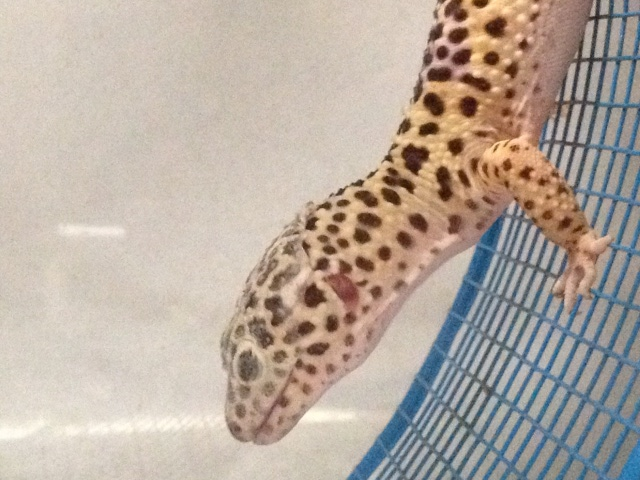 Leopard Gecko Eye Problem
QuestionClosed eye.
QUESTION: I have a four/fiv
Leopard Gecko Eye Problem
QuestionClosed eye.
QUESTION: I have a four/fiv
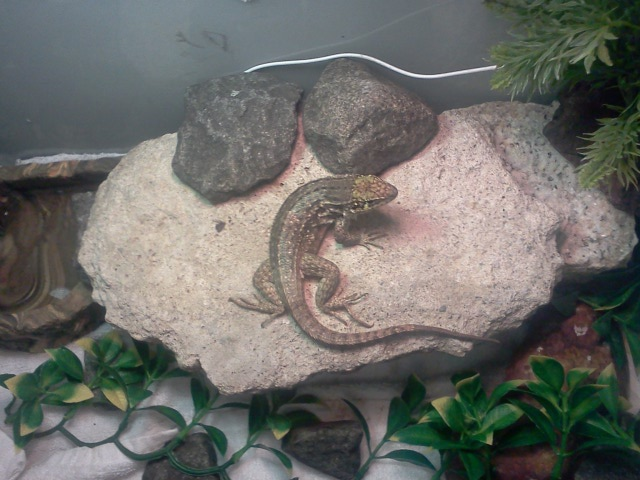 eating skin??
Question
My swift is shedding and pullin
eating skin??
Question
My swift is shedding and pullin
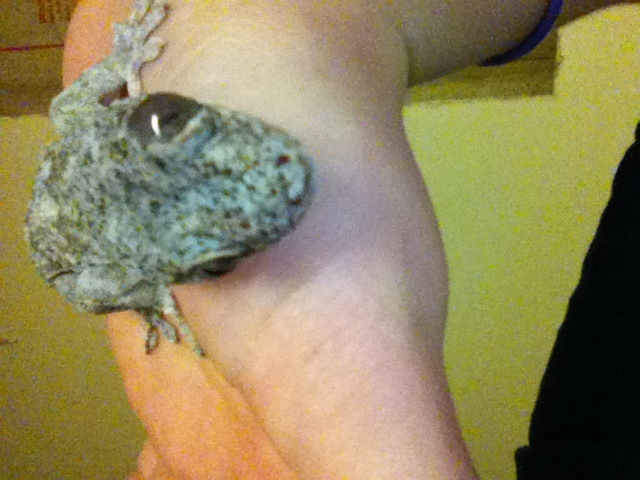 Vorax gecko
Question
Charlie
Hi. My vorax gecko named Charli
Vorax gecko
Question
Charlie
Hi. My vorax gecko named Charli
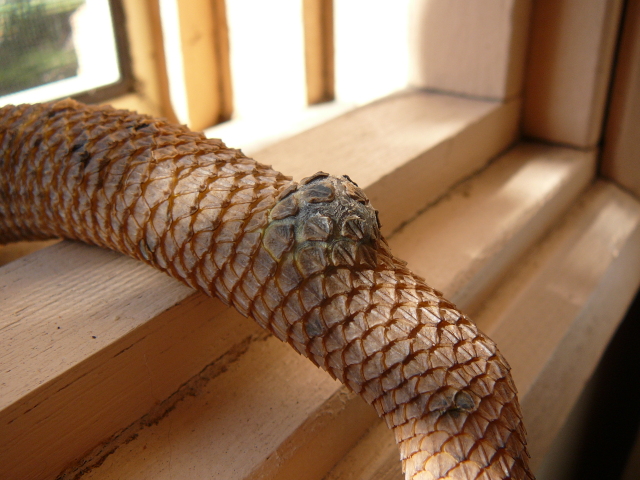 My beardie has developed a lump on her tail
QuestionTrigger
QUESTION: Hi, weve had Trigger f
My beardie has developed a lump on her tail
QuestionTrigger
QUESTION: Hi, weve had Trigger f
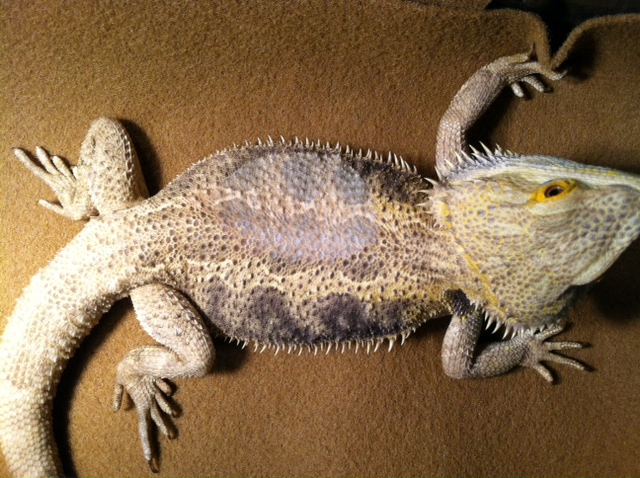 Bearded Dragon skin problem
Question
Bearded Dragon
Something is wrong with
Bearded Dragon skin problem
Question
Bearded Dragon
Something is wrong with